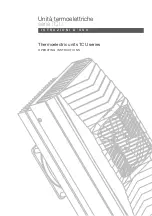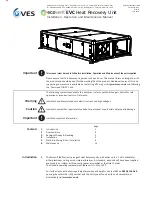
BASIC WELDING
FABRICATOR 252i
Manual 0-5155
4-11
BASIC WELDING
Art # A-07697_AB
Tack Weld
20°-30°
Electrode
Tack Weld
Figure 4-22: Butt Weld
Art # A-07698
Figure 4-23: Weld Build up Sequence
Heavy plate will require several runs to complete the
joint. After completing the first run, chip the slag out
and clean the weld with a wire brush. It is important
to do this to prevent slag being trapped by the second
run. Subsequent runs are then deposited using either
a weave technique or single beads laid down in the
sequence shown in Figure 4-23. The width of weave
should not be more than three times the core wire
diameter of the electrode. When the joint is completely
filled, the back is either machined, ground or gouged
out to remove slag which may be trapped in the root,
and to prepare a suitable joint for depositing the
backing run. If a backing bar is used, it is not usually
necessary to remove this, since it serves a similar
purpose to the backing run in securing proper fusion
at the root of the weld.
B. Fillet Welds
These are welds of approximately triangular cross-
section made by depositing metal in the corner of two
faces meeting at right angles. Refer to Figure 4-15.
A piece of angle iron is a suitable specimen with which
to begin, or two lengths of strip steel may be tacked
together at right angles. Using a 1/8" (3.2 mm) E7014
electrode at 100 amps, position angle iron with one
leg horizontal and the other vertical. This is known
as a horizontal-vertical (HV) fillet. Strike the arc and
immediately bring the electrode to a position perpen-
dicular to the line of the fillet and about 45º from the
vertical. Some electrodes require to be sloped about
20º away from the perpendicular position to prevent
slag from running ahead of the weld. Refer to Figure
4-24. Do not attempt to build up much larger than
1/4" (6.4 mm) width with a 1/8" (3.2 mm) electrode,
otherwise the weld metal tends to sag towards the
base, and undercut forms on the vertical leg. Multi-
runs can be made as shown in Figure 4-25. Weaving
in HV fillet welds is undesirable.
Art # A-07699_AB
45° from
vertical
60° - 70° from line
of weld
Figure 4-24: Electrode Position for HV Fillet Weld
Art # A-07700_AB
1
2
3
4
5
6
Figure 4-25: Multi-runs in HV Fillet Weld
C. Vertical Welds
1. Vertical Up
Tack weld a three feet length of angle iron to your
work bench in an upright position. Use a 1/8"
(3.2 mm) E7014 electrode and set the current at
100 amps. Make yourself comfortable on a seat
in front of the job and strike the arc in the corner
of the fillet. The electrode needs to be about 10º
from the horizontal to enable a good bead to be
deposited. Refer Figure 4-26. Use a short arc, and
do not attempt to weave on the first run. When
the first run has been completed de-slag the weld
deposit and begin the second run at the bottom.
This time a slight weaving motion is necessary
to cover the first run and obtain good fusion at
the edges. At the completion of each side motion,
pause for a moment to allow weld metal to build
up at the edges, otherwise undercut will form and
too much metal will accumulate in the centre of the
weld. Figure 4-27 illustrates multi-run technique
and Figure 4-28 shows the effects of pausing at
the edge of weave and of weaving too rapidly.
















































